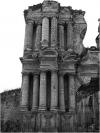Abstract
traveledto Guatemalan territory and overthrew the Quiché resistance. It was located at Iximché but, in 1527, after someuprisings, it was moved to the slopes of Volcano Agua. This new settlement was destroyed after a mudslide in 1541and the city was moved to the Panchoy Valley officially on March 10, 1543 where it lasted until its destruction in 1773.It remained in ruins until around 1860, when coffee was introduced. The entire city and its monuments transformedinto ruins over time and became a center enriched with the patina of time. Due to its historical importance that it is wellknown, today its importance also lies in that it is a city that is very much alive and preserved. The city has been a focalpoint of historical studies as well as studies in music, literature, paintings and sculpture and architecture. However,its architectural development and the architectural typology has not been studied systematically. For personal andprofessional interest, I have defined its evolution, from the Renaissance to Baroque, with a brief transitional period.Apuntes is registered under a Creative Commons Attribution 4.0 International Public License. Thus, this work may be reproduced, distributed, and publicly shared in digital format, as long as the names of the authors and Pontificia Universidad Javeriana are acknowledged. Others are allowed to quote, adapt, transform, auto-archive, republish, and create based on this material, for any purpose (even commercial ones), provided the authorship is duly acknowledged, a link to the original work is provided, and it is specified if changes have been made. Pontificia Universidad Javeriana does not hold the rights of published works and the authors are solely responsible for the contents of their works; they keep the moral, intellectual, privacy, and publicity rights.
Approving the intervention of the work (review, copy-editing, translation, layout) and the following outreach, are granted through an use license and not through an assignment of rights. This means the journal and Pontificia Universidad Javeriana cannot be held responsible for any ethical malpractice by the authors. As a consequence of the protection granted by the use license, the journal is not required to publish recantations or modify information already published, unless the errata stems from the editorial management process. Publishing contents in this journal does not generate royalties for contributors.


